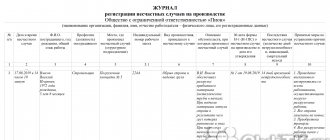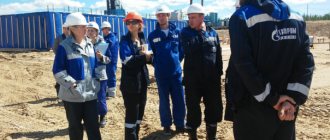No labor organization, unfortunately, can completely eliminate the likelihood of accidents at work. These are unfortunate moments, sad both for the victim himself and for his employer. They can be very diverse. Meanwhile, in order to investigate and further prevent such situations, as well as to pay compensation to the victim and build further labor relations with him, it is important to find out which category the incident falls into. In this article we will look at what groups industrial accidents can be divided into from the point of view of official regulations.
Definition of an accident
An industrial accident , also known as a work injury , is an unforeseen, unfavorable health incident that occurred with an employee at his workplace, on the way to work or from work (subject to delivery by the enterprise), or in another place during the performance of official duties. duties or tasks. A characteristic feature of an accident is damage to the health of the victim. A medical examination determines whether health is lost irreversibly (total loss) or partially, determining the degree of severity.
Occupational Safety and Health
Based on the analysis of industrial injuries and taking into account scientific and technical data, scientific research institutes for occupational safety, labor protection departments of ministries and departments, as well as safety services at enterprises and organizations are developing measures to combat injuries and occupational diseases.
These activities are divided into technical, sanitary and hygienic and organizational. Technical safety measures are as follows:
- replacement of dangerous production equipment with safe ones, the design of which is based on the principles that prevent injury to the worker.
- use of fencing for moving parts of machines and mechanisms.
- automation of loading and unloading of workpieces on machine tools.
- use of various safety devices. These include, for example, limit switches that limit the movement of a machine support, an elevator car, etc., loose links in mechanical systems that are triggered when a dangerous torque occurs, fuses or circuit breakers in the power supply circuit of electric drives, rupture discs in vessel systems operating under pressure, etc.
- arrangement of control panels and controls for production machines, eliminating erroneous operations, as well as the introduction of remote control and automatic regulation of production processes.
- widespread use of interlocks that prevent incorrect operations when switching in electrical circuits when controlling production machines and units.
- comprehensive mechanization and automation of production processes.
- periodic testing of production equipment, hoisting and transport machines, electrical equipment with increased loads, increased voltages, etc.
- use of personal protective equipment and safety devices.
Technical measures for industrial sanitation include the following:
1. Correct standardized lighting of workplaces and premises.
2. Rational heating of industrial premises and protection from cold or harmful thermal radiation.
3. General and local ventilation. Air conditioning.
4. Measures to combat noise and vibration.
5. Replacement of harmful substances and materials with less harmful or harmless to humans.
6. Rational arrangement of water supply and sewerage.
7. Ensuring the cleanliness of workplaces and production premises.
Along with technical measures, organizational measures are carried out, which include the following:
- Strict compliance with labor laws.
- Thorough investigation and recording of accidents and occupational diseases.
- Timely implementation of scheduled preventative repairs of production equipment.
- Conducting factory (shop) labor safety inspections.
- Training workers and conducting briefings on occupational safety and health.
- Organization of offices and occupational safety corners.
- Conducting lectures on labor protection, showing films on labor protection.
- Development of local safety instructions.
- Use of posters, warning notices and signs.
- Conducting lectures, seminars and consultations on labor protection.
Each employee must comply with occupational safety measures, which include compliance with safety and personal hygiene rules, compliance with production discipline and internal regulations, keeping the workplace clean and tidy, compliance with local production instructions, and the use of personal protective equipment.
Regulatory basis for the classification of accidents
The specifics of dividing industrial injuries into classes are regulated by a number of legislative norms:
- Order of the Ministry of Health and Social Development of the Russian Federation dated February 24, 2005 No. 160 establishes a scheme for determining the severity of the resulting harm to health;
- Order of the Federal State Statistics Service (Rosstat) dated July 19, 2013 No. 216 - approves the annex to Form No. 7, which lists and groups the causes that led to an industrial injury;
- Labor Code of the Russian Federation (Article 227) - speaks of the mandatory investigation of the NS and payment of compensation, depending on the severity of the consequences.
FOR YOUR INFORMATION! A single generally accepted classification of accidents at work has not yet been approved.
The main causes of occupational diseases at work
The causes of occupational diseases are similar to the causes of industrial injuries. They are divided into 5 groups:
- Technical. This group includes production problems with machines, units, and devices. For example, malfunction, leakage of toxic liquids, ventilation problems.
- Organizational. Lack of management control, no protective equipment provided, violation of rest time, lack of instruction and prevention.
- Economic. To this group are added insufficient funding for labor protection, unacceptable reductions in staff, and reductions in time standards.
- Sanitary and hygienic. Failure to comply with sanitary standards, vibration, low lighting, gas pollution, hazardous radiation.
- Psychophysiological. Here they note the fatigue of the worker, the monotony of the actions performed, and the negative atmosphere of the team.
Some experts identify an additional group of reasons, which contains factors emanating from the worker. For example, deliberate violation of labor safety standards, arriving at work drunk.
Types of accidents at work
Depending on the basis taken as the basis for the classification, several groups of NS in production can be distinguished:
- By number of affected participants:
- individual – happened to 1 person;
- group - two or more people took part in them simultaneously.
- According to the severity of the consequences received (the qualifying feature is the characteristics of the injuries received, their possible consequences, reversible or not, their duration in time):
- microtraumas – the ability to work is not lost, health is quickly fully restored within 1 working day or a little more;
- mild – injuries of mild to moderate severity, allowing full restoration of working capacity over time;
- severe - some consequences are irreversible, that is, a person becomes disabled as a result of the NS;
- fatal – the result of the incident was death.
- Due to the injury that occurred:
- technical (engineering) reasons - depend on the imperfection of technologies, materials and means of protection, as well as on the lack of provision of mechanisms;
- organizational reasons - caused by the level of labor organization throughout the enterprise and at a single workplace;
- personal (psychophysiological) reasons – what is called the “human factor”.
A complete list of possible causes of accidents is given in Appendix No. 1 to Order No. 21 - this is a special classifier intended for filling out forms and reports when investigating industrial injuries.
Modern production is complex and multifaceted. Most often, a work-related injury results from a combination of several causes or a coincidence of events, called an accident. In the first place among the factors are violations of labor protection requirements. Even if they are safe individually, when taken together, under certain conditions, they can lead to an accident. What unites them is their participation in human events - this is always an unpredictable factor.
NOTE! Whatever the cause of the accident, it will still be led by a person: his incorrect/untimely action/inaction.
Causes and types of accidents
Every investigation begins with finding out what caused it. For the convenience of carrying out investigative actions, the main causes of industrial accidents are divided into 4 groups.
- Organizational causes of accidents. Associated with improper work organization, low qualifications, inability to apply safe work practices, poor management control, failure to provide personal protective equipment, etc.
- Technical causes of accidents. These include working with a faulty tool, violation of deadlines for verification and repair of equipment, and incorrect choice of operating mode for the tool.
- Sanitary and hygienic. The onset of extreme weather conditions, deterioration of ambient air parameters (gas, dust), insufficient lighting in the workplace, thermal radiation, etc.
- Psychophysiological. The work involves a lot of stress, requires increased attention, and leads to rapid fatigue.
Incorrect actions of people, the so-called human factor, most often lead to accidents at work.
The legislator has identified more than ten types of accidents. The full list is given in the Order of Rostrud dated February 21, 2005 No. 21 (Appendix 5).
This register serves to ensure proper interaction between Rostrud and its regional divisions when organizing investigations into the causes of accidents with serious consequences.
The legislator has identified the following types of accidents with serious consequences:
Minor accidents
Minor accidents at work are considered to be injuries or resulting harm to health, which are accompanied by temporary loss of ability to work for a period of no more than 60 days, as well as loss of professional ability to work by no more than 20%. An opinion on this is provided by a medical commission.
- transport received on any type of transport, at work or on the way to work, from work, on a business trip, etc. (read about work-related injuries on the way to work here);
- falling from height;
- collapse of walls, rocks, earth, snow, etc.;
- impact from moving machine parts;
- entry of foreign bodies into natural orifices of the body;
- physical overload and strain when lifting heavy objects, carrying parts and objects;
- electric shock;
- thermal burns;
- poisoning, inhalation of toxic fumes, improper handling of hazardous substances;
- contact with poisonous and dangerous animals, insects, plants;
- on water, drowning when falling into water;
- caused by illegal actions of other persons, as well as the occurrence of man-made disasters, explosions, earthquakes, natural disasters;
- others.
The employer is obliged to report every accident with serious consequences to the Department of Supervision and Control over Compliance with Labor Legislation or the duty department of Rostrud, if the event did not occur on a working day.
When filling out the document form established by the Order, the employer indicates the cause and type of accident, a list of which is given in the appendix.
Questions related to the causes and prevention of industrial accidents are discussed in this video
Classification of accidents from the point of view of investigation
Each accident must be investigated, which is documented in accordance with the law. The degree of harm caused to the victim’s health must be indicated. Since this document will have force and further legal consequences, the severity of the case cannot be indicated arbitrarily. There is a medical examination for this. The legislative basis is the already mentioned order of the Ministry of Health of the Russian Federation No. 160.
He does not consider the possible causes of a work injury, paying attention only to two characteristics of the incident:
- to what extent the employee’s health was damaged and whether the damage affected the course of existing chronic diseases;
- how long this damage will persist over time, that is, whether the consequences for work ability will be permanent or irreversible.
IMPORTANT! Any of these signs, even in the singular, is qualifying for establishing the degree of severity.
According to this principle, all consequences of industrial injuries are divided into mild and severe.
Not heavy means light
The leading principle in this division is the principle of exclusion. The order regulates severe NS, all others are automatically classified as mild. Let's consider what the Ministry of Health means by the serious consequences of industrial injuries.
A severe degree of health damage due to work-related illness implies a sharp disruption of the normal state, which causes loss of ability to work for more than 1 month, possibly with lifelong consequences (disability).
FOR YOUR INFORMATION! The first sign of the undoubted severity of the case is a threat to the employee’s life due to damage to health. If, due to his injuries, he theoretically could have died, then the case will definitely be considered serious, even if help was provided on time and the person remained alive.
A special table in this Order describes the possible severe consequences of an industrial accident.
3 degrees of damage severity
Severe consequences are divided into 3 stages in descending order of the danger of bodily injury and the irreversibility of their consequences:
- Damage that was initially caused by shock, hemorrhage (blood loss), problems with vital organs (liver, kidneys, lungs, heart, cardiovascular and central nervous system). NS is considered severe, even if a person recovers fairly quickly from such injuries.
- Delayed consequences - do not appear immediately, but are identified by an ambulance doctor, emergency room, intensive care unit, etc. Examples include skull fractures and wounds, spinal injuries, organ ruptures, miscarriage during pregnancy, burns affecting more than 15% of the body, and other severe injuries.
- Severe consequences, irreversible, but not life-threatening, for example:
- blindness (in 1 or both eyes);
- numbness and/or deafness;
- loss or cessation of functioning of any organ;
- disfigurement (facial trauma);
- mental disorders.
A special case
Sometimes the injury itself is not so serious that it may be considered severe. But it becomes a catalyst for processes that cannot be stopped, and they can lead to death. In such a situation, NS is also considered severe.
An example is the unfortunate case of singer Anna German, who was in a car accident. Having received many fractures, she suffered for 15 years from severe pain, thrombophlebitis and ultimately died from sarcoma - cancer in the bones. A forensic examination proved that all these problems occurred as a result of the injury.
Classification of occupational diseases in production
The classification of such ailments involves five groups, among which the following are distinguished:
- Ailments under the influence of chemical factors. Such diseases include various types of intoxication along with their consequences.
- Diseases caused by dust, dirt, etc.
- Diseases due to physical factors. These include hypothermia, heat stroke, and laser radiation.
- Ailments caused by stressful situations and overexertion.
- Deterioration of health due to biological factors. These include infectious pathologies.












